![Hyōtan kozō - [Yokai|Tsukumogami]](http://samkalensky.com/cdn/shop/files/IMG_2363_{width}x.jpg?v=1761415673)
Hyōtan-kozō - 瓢箪小僧 (ひょうたんこぞ ) - [Yokai | Tsukumogami] - "Gourd Boy"

• About this yokai: Once a hollow, antique drinking gourd, normally used as a bottle or a flask, but instead of holding “spirits" it was used superstitiously as a vessel to contain bad luck. Eventually the energies of which, turned it into a Tsukumogami; now its hollow head hangs heavily with a sad, sickly appearance. (Perhaps it was filled too much for its own good…) It sprouts wilted, dying leaves from its back; and so, it resembles a gourd once more. This yokai is known to suddenly roll out of a thicket when you aren't expecting it; The sight of which causes monks to riot in prayer!
• Origin: "Hyōtan-kozō" is yet another Tsukumogami which Toriyama Sekien included in his "Gazu Hyakki Tsurezure Bukuro" [1784] it appears along side "Nyubachibo" a Tsukumogami of a hand cymbal. - Sekiens included description translates closely to as follows:
"Shocked green at the sight of gourd boy, mortar monk clashed his cymbals together loud enough to wake me from my dream." - [Translation: Japandemonium 2017]
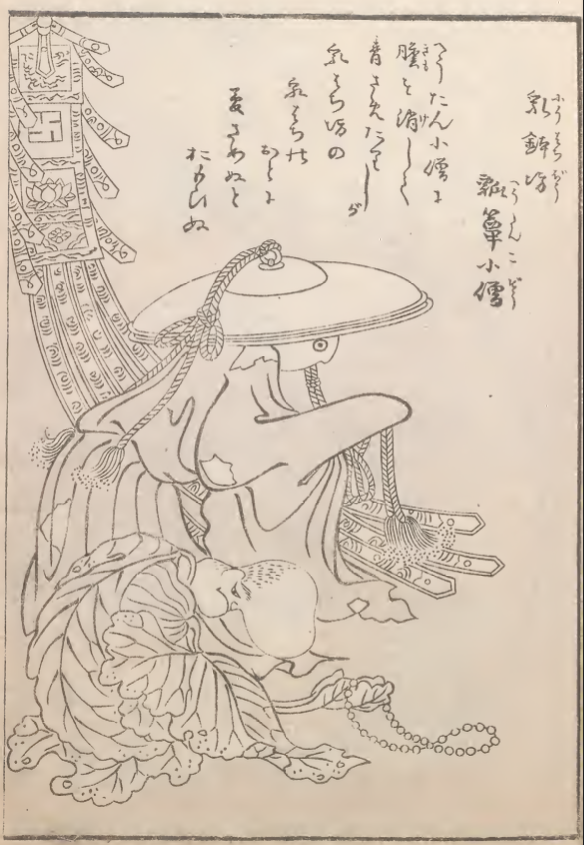
• The Antique in Question: Hyōtan (also called Tokkuri) are Calabash gourds, which have been fashioned into bottles & used as canteens for holding liquid or alcohol, especially Sake! (They are the oldest traditional flask used for the drink!) Today these gourds are a bit more of a folk-craft than anything used conventionally. (You can learn to make one for yourself here!)
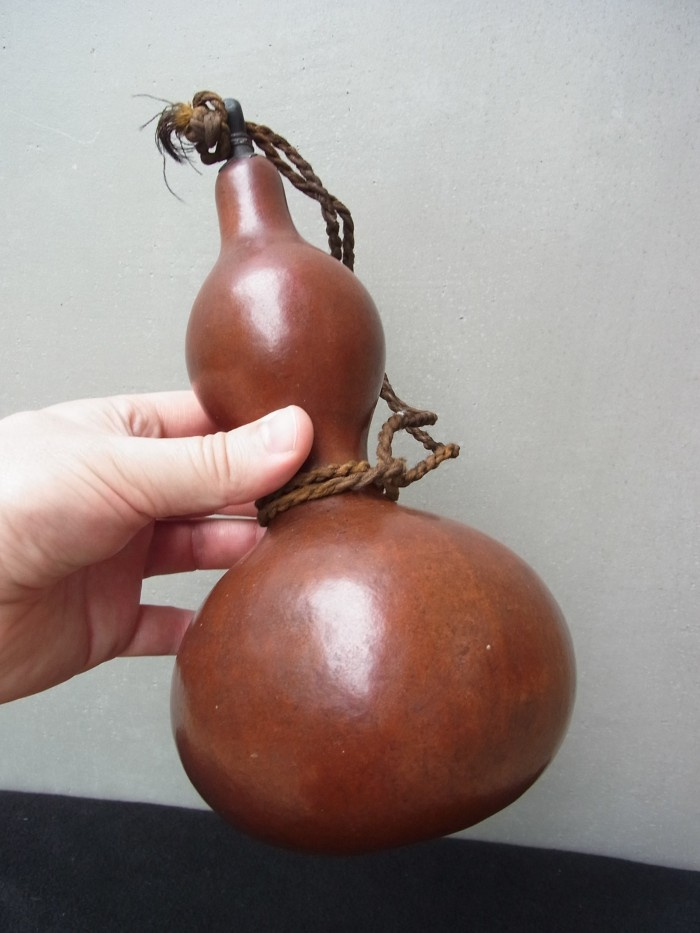
[a traditional hyotan drinking gourd - image source]
• History: As the two yokai share a page; This yokai is often overlooked or lumped in with the mortar monk, Nyubachibō. (see also Nyubachibō.) The tapestry behind them seems to imply a ritual or funeral, perhaps Nyubachibō was so startled about the gourd boy's sickly appearance; that he held a funeral for him right then and there! Toriyama also jokes that the Cymbal monk was so noisy that it even startled him awake from his dreams!
…Ultimately there was very little written about this yokai, so speculation abounds; In his 1994 Yokai Encyclopedias, Shigeru Mizuki embellished a little; adding that Hyōtan-kozō will “suddenly appear out of a thicket and pop out to surprise people!” (Reminds me of Shirodokkuri, another flask yokai.) Other yokai experts; such as Kenji Murakami, also elaborated & related this yokai to popular folkloric beliefs such as ’hanging hollow gourds to prevent bad luck and disease.’ Comparing it to ritual, hina-okuri dolls which (among other ‘hollow things’) might be used to trap misfortune or bad energy. It has also been said that there was a belief that growing gourds in ones garden may cause a disaster! (For a ghost story along those lines, see also; Neko Kabocha.) I’ll add one more ‘Hyotan-adjacent folklore fact’ here myself, (although its somewhat contrary to those mentioned thus far) in Chitose, Oita prefecture there is also the Hyōtan-gourd-festival aka “The Shimotsuki Festival” of Shibayama Hachiman Shrine. The celebration, which has been held for 800 years, is led by a man dressed as Hyōtan-yokai named “Hyotan sama’ (ひょうたんサマ) or “Sir Gourd” He runs about the village with comically large straw sandals, a large gourd sitting atop his head, and a flask filled with sake, chanting: "For a good harvest, for your good health, here comes the sacred rice wine!" [1.] Everyone drinks and has a good time!
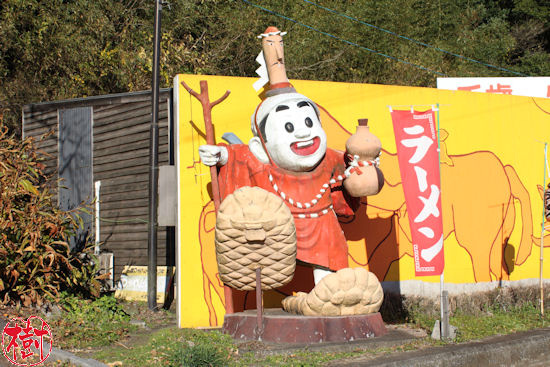
[a sign featuring hyotan-sama image source]
• Earlier appearances/similar yokai: Of course goes without saying that yokai in the shape of drinking gourds & flasks appear quite widely across various picture scrolls & Japanese folklore in general. - Both Nyubachi and Hyotan-kozo are often compared to two similarly shaped, unnamed Tsukumogami which arew depicted in earlier Muromachi period (1333-1573) - "Hyakki Yagyo Emaki" picture scrolls, which Sekien referenced in his books preface, as being inspiration for many of his yokai.
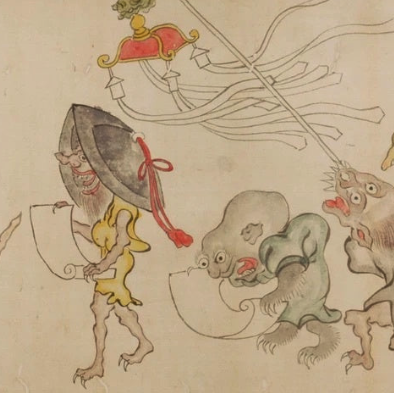
[A Long Nosed cymbal wearing yokai followed by a large-’gourd’-headed bakeneko? They appear to be reading scrolls, likely chanting sutras.]
• See also: Nyubachibo. Hanging gourds,
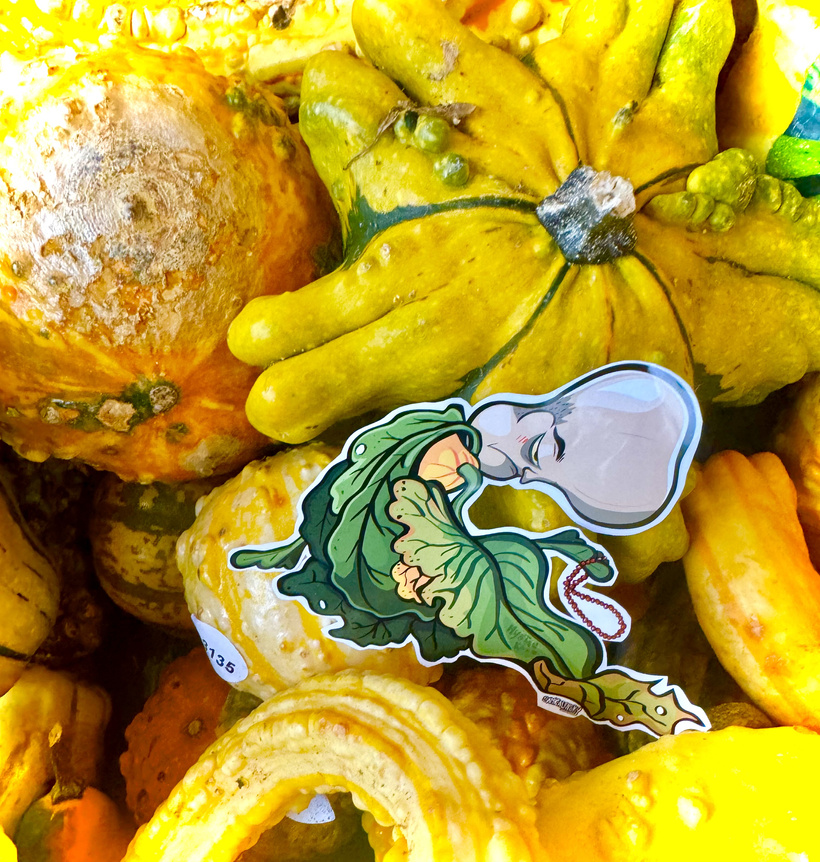
[Art sticker by @SamKalensky (Yo thats me!) part of my “Hyakki Yagyo night parade of 100 yokai.” Sticker collection! - Follow and support my work for many more!]

![Hyōtan kozō - [Yokai|Tsukumogami]](http://samkalensky.com/cdn/shop/files/IMG_2373_{width}x.jpg?v=1761415698)
![Hyōtan kozō - [Yokai|Tsukumogami]](http://samkalensky.com/cdn/shop/files/IMG_2359_{width}x.jpg?v=1761415698)
![Hyōtan kozō - [Yokai|Tsukumogami]](http://samkalensky.com/cdn/shop/files/IMG_2365_{width}x.jpg?v=1761415698)
![Hyōtan kozō - [Yokai|Tsukumogami]](http://samkalensky.com/cdn/shop/files/IMG_2366_{width}x.jpg?v=1761415698)
![Hyōtan kozō - [Yokai|Tsukumogami]](http://samkalensky.com/cdn/shop/files/IMG_2376_{width}x.jpg?v=1761415698)
![Hyōtan kozō - [Yokai|Tsukumogami]](http://samkalensky.com/cdn/shop/files/IMG_2375_{width}x.jpg?v=1761415698)
![Load image into Gallery viewer, Hyōtan kozō - [Yokai|Tsukumogami]](http://samkalensky.com/cdn/shop/files/IMG_2363_110x110@2x.jpg?v=1761415673)
![Load image into Gallery viewer, Hyōtan kozō - [Yokai|Tsukumogami]](http://samkalensky.com/cdn/shop/files/IMG_2373_110x110@2x.jpg?v=1761415698)
![Load image into Gallery viewer, Hyōtan kozō - [Yokai|Tsukumogami]](http://samkalensky.com/cdn/shop/files/IMG_2359_110x110@2x.jpg?v=1761415698)
![Load image into Gallery viewer, Hyōtan kozō - [Yokai|Tsukumogami]](http://samkalensky.com/cdn/shop/files/IMG_2365_110x110@2x.jpg?v=1761415698)
![Load image into Gallery viewer, Hyōtan kozō - [Yokai|Tsukumogami]](http://samkalensky.com/cdn/shop/files/IMG_2366_110x110@2x.jpg?v=1761415698)
![Load image into Gallery viewer, Hyōtan kozō - [Yokai|Tsukumogami]](http://samkalensky.com/cdn/shop/files/IMG_2376_110x110@2x.jpg?v=1761415698)
![Load image into Gallery viewer, Hyōtan kozō - [Yokai|Tsukumogami]](http://samkalensky.com/cdn/shop/files/IMG_2375_110x110@2x.jpg?v=1761415698)